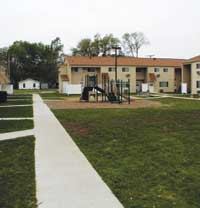A New Hope
The new FHA ruling is expected to ease many of these problems at Section 515 properties, which serve more than just aging farmers. While the elderly and handicapped and disabled residents represent 60 percent of Section 515 households, these properties also house minorities (30 percent of households) and women, who head about three-quarters of Section 515 households.
That’s the case in Celina Gardens, where single mothers with children comprise the bulk of the residents. While these people probably aren’t familiar with references to Section 515 properties, Section 538 loans, or even USDA Rural Development, they will notice the changes these programs and people from halfway across the country have made in their lives.
“We will be completely renovating the property,” Boone says. “We want to increase the natural light and open it up. We want to make the units larger. We will knock down the walls and expand the size of the units. The kitchens are narrow and very, very dark. We will knock walls and cut an opening where you have bar stools around a large counter.”
Without the changes from FHA, this wouldn’t have been possible. “I guess the property would have still lasted a long time,” Boone says. “But it would have continued to deteriorate. It could have become a slum.”
